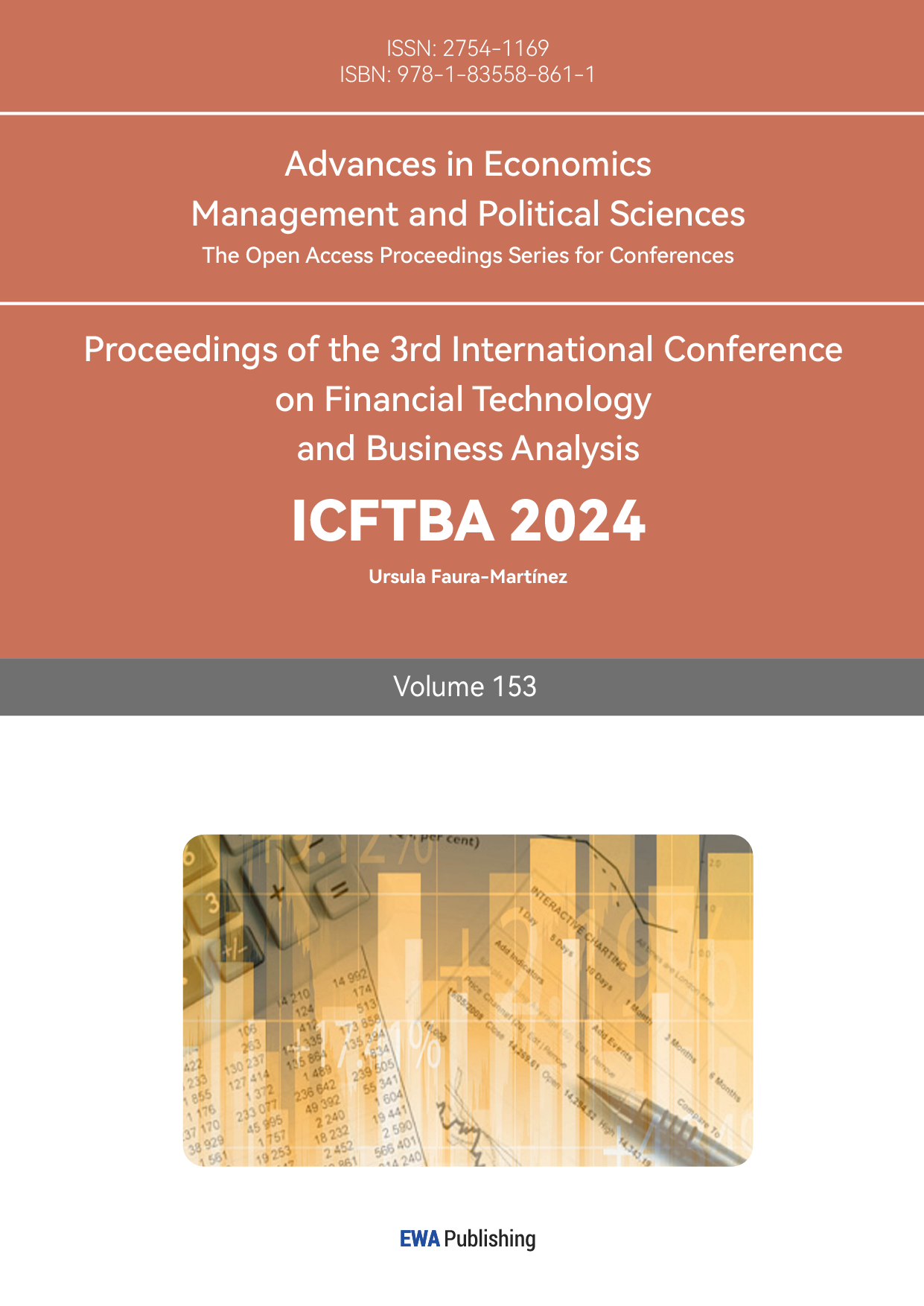1. Introduction
By observing the overall development situation of the toy industry, this explore selects LEGO as the leading company and monopoly as the research object, aiming to explore the overall situation and countermeasures of LEGO under the environment of economic downturn and fierce competition among peers, so as to project the analogy research and observation to the entire entertainment toy industry. It can help user to better access the company's situation and product information and make it convenient to respond. As an established and strong supplier in the toy industry, LEGO has essentially a monopoly on the sales and research and development of building block toys in the international market through its rich variety of LEGO products and extensive research and development efforts. At the same time, it has carried out certain developments and cooperation in different fields, such as the film and television industry, the gaming industry and the education industry. He has also made great contributions to international issues and the development of young people and children. Using case analysis method, comparative analysis method and secondary data analysis method, this explore first discussed LEGO's basic situation and market strategy, such as product innovation and promotion, sustainable development and fund investment, and maintaining customer loyalty, and then discussed the challenges under the current economic environment, such as the emergence of homogenization and localization products, and copyright infringement of pirated products. Finally, it analyzes coping strategies for LEGO and the toy industry as a whole, based on LEGO's solutions to past crises.
2. Overview of LEGO
2.1. Lego Definition and Character
LEGO's name comes from the Danish "Leg-Godt", meaning "play well", and in Latin means "fit together", there are colorful plastic blocks, gears, miniature figures and various other parts, can be formed into a variety of model objects, can be assembled and wired in a variety of ways to build objects, with building objects, vehicles, people as the main model. Anything constructed can be taken apart and reused to make something new.
2.2. Basic Information About LEGO
The LEGO Group began with the workshop of carpenter Auer Kirk Christiansen from Denmark, designed the "LEGO" trademark in 1934, and then entered the 2018 World's top 500 brands, ranking 98th. Lego is currently the largest player in the Chinese building block toy market, ranking first in terms of absolute market share. Lego Group's top management now consists of a seven-member executive leadership team and a board of directors. Lego's share of the global toy market was 9.5 percent in 2020, and its share of the global building block market was as high as 68.6 percent. According to Table 1, Lego has a 43.6 percent market share of construction toys in China in 2021 and its leading position is stable, while Mubang High-tech CO., LTD, Keeppley, Star Diamond and KUB have relatively low market share of no more than 5 percent [1]. In the Economic Daily 2023, it was proposed that in 2022, the LEGO Group will open 155 new flat auction retail stores worldwide, with more than 90 of them located in China. In 2023, LEGO will have a total of 1,031 branded stores worldwide, of which 147 will be added, compared to 2022 [2].
Table 1: Global building blocks market share
Brand | Proportion |
LEGO | 43.6% |
KUB | 1.6% |
Mubang High-tech CO., LTD | 4.5% |
KEEPPLEY | 4.2% |
STAR DIAMOND | 2.1% |
Others | 44.0% |
2.3. LEGO Revenue
Figure 1. is Lego's 2022 year-end report, it stated: Revenue of 64.6 billion Danish krone, an increase of 17% over 2021, and operating profit of 17.9 billion Danish krone, an increase of 5%. Meanwhile, net cash flow was 9.3 billion Danish krone, and the return on investment was 77.8% [3]. Figure 2 is the Lego Company's 2023 annual report, which states that Lego was outperformed toy market and gained significant market share. Revenue was 65.9 billion Danish krone, up 14% from 2019 to 2023, while operating profit was 17.1 billion Danish krone, up 12% in four years. Net cash flow was 6.9billion Danish krone and return on investment was 57.1% [4].
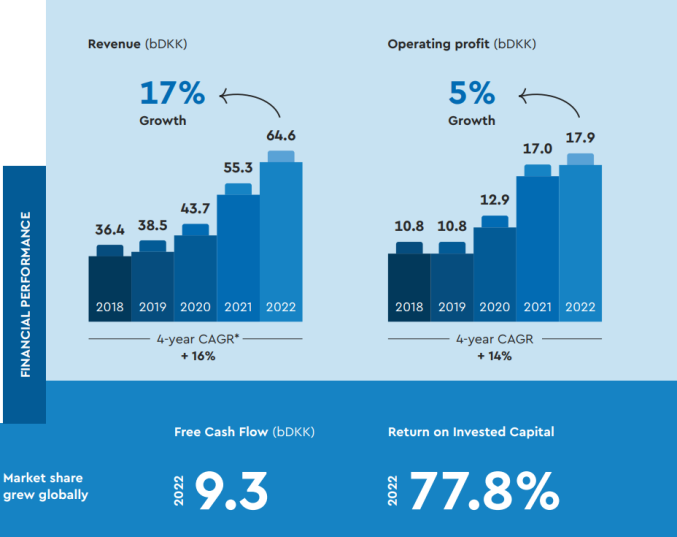
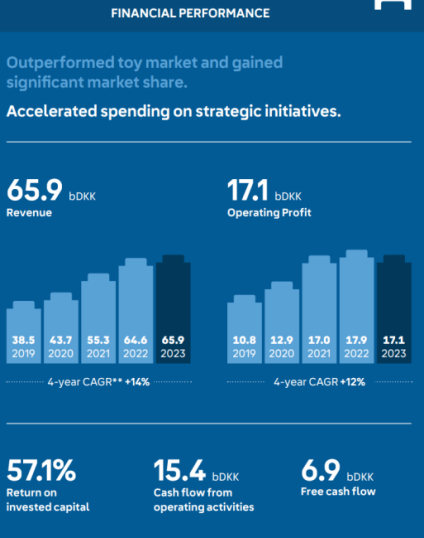
Figure 1: Annual Report 2022 Figure 2: Annual Report 2023
3. Market Strategy
3.1. LEGO Marketing
3.1.1. Product Innovation and Diversification
Lego was founded with the intention of implementing the toy system project, and had co-branded many famous games, movies, landmarks, and celebrities (Figure 3 and Figure 4). The company released its first Lego set in 1964, one of its most successful collections, the Train System, in 1966, the Technology series in 1977, the Lego Man series in 1978, the second most important design after the bricks, and the Castle series in 1984. At the same time, LEGO founder Orke Christiansen placed great emphasis on LEGO's educational development for children, releasing DUPLO sets for young children in 1969 and later the DUPLO Baby series in 1983. After gaining a foothold in the toy industry, LEGO released its first computer game, Lego Pirates, in 1997, followed by a chess computer game and RCX, a programmable building block compatible with motors, in 1998.Annual Report 2022 shows that 48% of the product portfolio is new [3]. In the Annual Report 2023, 47% of Lego's investment in products was in new products. Lego has three popular themes and has released new homegrown IP themes and entertainment series [4]. LEGO escaped from being nearly bankrupt ten years ago, to occupying the top spot in the toy manufacturing business with their amazing business model turnaround story [5]. And the LEGO Official website states that LEGO play offers the chance if constant discovery - the possibility of creating something new every time.
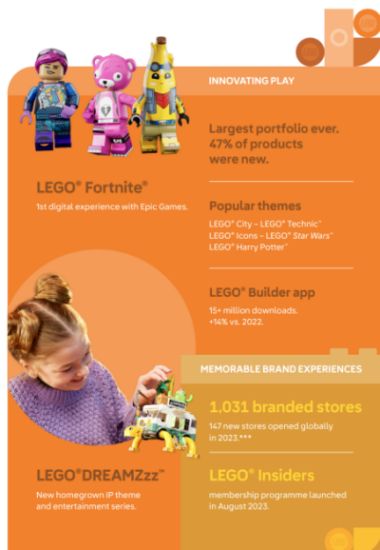

Figure 3: Annual Report 2023 Figure 4: LEGO Theme Package
3.1.2. Market Positioning and Brand Building
Marketing positioning:
“LEGO as a tool for supporting creative thinking, developing creative cultures, and contributing to processes which might make a difference in how the world works.[6]” Slogan of LEGO is only the best is good enough, and they have four commitments to their consumers: constantly innovating, never compromising, building, rebuilding and striving for the best. The company's position on itself is “A global force for Learning-through-Play”, main mission is “inspire and develop the builders of tomorrow”. Lego started out with the idea of creating bricks for children to play with, and then the Lego company set the belief that Children are our role models. They hope that children can enjoy the process of playing with legos and enjoying toys to build essential life skills, learn to solve problems and boost confidence, creativity and resilience. So, they focus on creating an environment where kids can play with Lego and take social responsibility.
Brand building:
At the same time, the Lego brand pays attention and pays attention to construct 1. Imagination, Lego provides a Minecraft-like world for players to dream about in real life; 2. Creativity, combining logic, rationality and imagination, players can apply Legos to create whatever buildings, characters and worlds they want; 3. Fun, when the player fully invests his energy into the game and finds that his ability can support his imagination, it will yield satisfaction and happiness; 4. Learning, allowing players to remain curious and practice, while giving players different ways to build and develop a new world, while promoting themselves as puzzle games, linked to education; 5. Caring, Lego is committed to making a positive impact on children's lives; 6. Quality, as the world's largest toy brand, Lego Company not only ensures the safety and strength of parts in the selection of materials, but also ensures the beauty and players have a smooth integration process.
3.1.3. Product Promotion and Sales
LEGO has been expanding its product line since the beginning, not only creating its own IP, such as LEGO mini figures series, but also maintaining the tradition of co-signing with other well-known IP companies, such as cooperating with Disney, Marvel, DC Comics, creating Star Wars and superhero themed series, and cooperating with movie manufacturers. “The Lego video game series is financially successful outselling traditionally produced licensed video games. The Lego series also receives critical acclaim from both gaming magazine reviews and user reviews [6].” Filming the LEGO universe, such as the Batman movie and the Phantom Ninja films, building LEGO theme parks around the world in countries such as California, Florida, Malaysia, Japan and Germany, and creating video games based on different product lines, quickly breaking the LEGO brand and connecting it with real-world mechanical vehicles, For example, LEGO TECHNIC co-signed with automobile brands to simulate real automobile manufacturing, changing the stereotype that LEGO is only for children to play in the public cognition, and expanding the brand influence; after the later research found that the main consumer group was boys, the Princess series and the City Street View series established contact with the girl consumer group and expanded its consumer group; later, in order to expand brand awareness, Lego participated in and held a series of competitions, such as the LEGO Master and other official competition programs, the FIRST International Lego League (FLL) to develop STEM skills and teamwork skills, and World Robot Olympics(WRO). LEGO's Facebook and Instagram pages are regularly updated with images and videos of new creations, and as of June 2020, Lego is also the most popular brand channel on YouTube, featuring new product promotions, Lego educational videos, and how-to-build videos. “LEGO is a good source of inspiration for companies in Latvia that want to create a strong brand story, thereby increasing their visibility through communication via social media. [7]” The company has also encouraged fans to create their own LEGO-related channels, such as Beyond the Brick, a promotional channel independent of the company, and LEGO Magazine, which provides an introduction to LEGO products and increases brand awareness and communication.
3.2. Business Strategy
3.2.1. Customer Retention
LEGO Builder app:
LEGO Company has a special LEGO app, in the Annual Report 2022 shows that 13.6 million people have downloaded the LEGO Builder app, an increase of 42% over 2021, in the Annual Report 2023 shows that the LEGO Builder app has now been downloaded by more than 15 million people, an increase of 14% over 2022 [3]. LEGO Builder (Figure 5) provides specific assembly instructions and videos, and also provides an assembly function called build together, which increases the thinking and fun of teamwork. At the same time, applyrs can query any question here, which increases the convenience.

Figure 5: LEGO Builder app
Membership:
Meanwhile, LEGO launched a membership programme called LEGO insiders (Figure 6) in August 2023. Only people over the age of 18 can register for full membership rights and benefits. Membership levels are determined by the purchase amount, and different membership levels have different exclusive rights and interests. Examples include birthday gift certificates, upgrade gift certificates and offline event priority certificates. This membership system allows members to purchase new co-branded collections in advance and can also play or watch certain videos that are only available to members. This system increases customer loyalty, spurs consumption and expands profits.
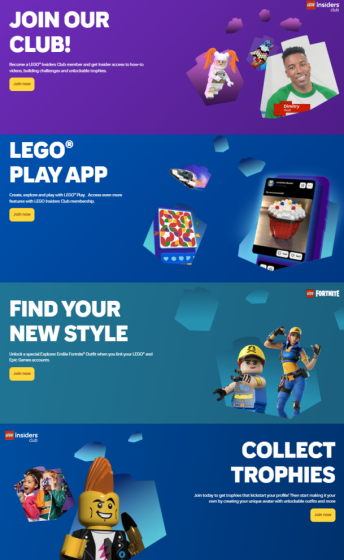
Figure 6: Membership
LEGO was originally designed as a toy for children. Later, it built different and diverse systems and IP to attract more customers, resulting in a wide age range. To that end, LEGO offers a special social application for children under 13, LEGO Life, on which customers can share their LEGO accomplishments. Reviews of other people's work, as well as insights into the integration of different Lego series. At the same time, for adult customers, LEGO has opened an online community called "LEGO IDEA", where these applyrs can create, share, innovative suggestions and other activities that are meaningful to the future development of the company and product innovation. These social software and platforms enhance customer connections, enhance customer loyalty, and help companies better understand customer needs.
3.2.2. Sustainable Development
LEGO values children's education, life and other development, as well as environmental protection, social responsibility and other issues. In 2020, LEGO Group will actively promote gender equality and women's empowerment in society and the workplace through the UN Women's Empowerment Principles. In the sustainability report 2023, 9.86 million children have been influenced by LEGO through offline community activities, 11.8% more than the estimated 8.82 million. Lego's flagship social impact program has also influenced two million children. Lego has also organized a 2-Workday Volunteer Program to promote social responsibility and help maintain the environment in the community. Lego attaches great importance to environmental issues. According to its 2022 financial report, more than 50 percent of its components are made of bio-PE, a new environmentally friendly material, and a total of 138 suppliers, 73 percent more than in 2021, are participating in the Engage-to-Reduce program to reduce emissions [3]. In Annual Report 2023, Lego stated that it had increased its spending on environmental initiatives by 60 percent in 2023 compared to 2022 [4]. In sustainability report 2023, LEGO is aiming for net-zero emissions by 2050. In order to develop globally, Lego will expand its factories in Hungary, Mexico and China, as well as Vietnam and the United States, where two new plants will be built to increase production to ensure output.
4. Monopoly Analysis
4.1. LEGO’s Advantages and Reason Analysis
4.1.1. LEGO System
Lego's early success was built on patents and high standards. In 1958, LEGO filed its first patent for an improved version of the self-locking block, and Lego's unique construction of building blocks also provided the specificity and feasibility of building blocks. Later, in 1955, Lego proposed the concept of "Lego System in Play" and began to create LEGO series of toys, such as Lego Train series, Lego Street View series, Lego Castle series. The explosion in sales of the Lego Villains series, and the mutual integration and connection that built the Lego toy ecosystem, formed a barrier. After a period of downturn, Lego to build a system, IP co-branding and community to re-create new barriers, while Lego with high profits to increase staff salaries, investment in advertising marketing, new product research and development to reach the height of other enterprises difficult to reach, basically occupied the international market. At the same time, Lego has entered the film and gaming industries, built parks and expanded its brand awareness and influence.
4.1.2. Education and Foundations
LEGO has created a series of websites, such as LEGO Education, LEGO Foundation, LEGO House, shown in Figure 7. Among them, the LEGO Education website emphasizes education and fun, and uses Lego as an educational toy to cooperate with educational institutions and education administrations around the world. Lego educational materials are selected by public institutions, and numerous world-class competitions and educational courses are held. “`Build a Self-Driving Car' of LEGO® for computing lessons at schools will be extended by learning units for IoT Testing [8]”. The LEGO Foundation website is designed to allow children to learn through play and exploration, building a world of playful learners. Targeting children under the age of 12 and adults such as parents and teachers, they provide grants to NGOs, non-profit organizations and research institutes, and work with other founders and governments to fund early education, support parenting programs, and work with the Department of Education to bring fun learning into the classroom. This is something that no other toy company can do.
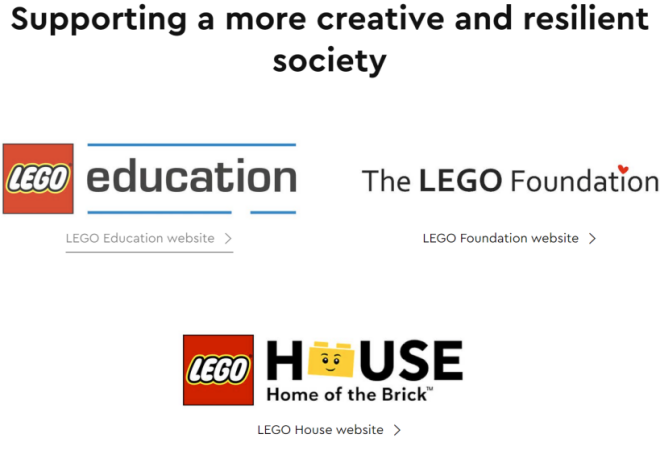
Figure 7: LEGO Website
5. Difficulties and Solutions
5.1. New Competitors and Market Changes
5.1.1. Internet Development and Entertainment Innovation
According to Figure 8, LEGO experienced 15 years of rapid growth between 1979 and 1933, with an average annual growth rate of 14%. From 2000 to 2004, however, LEGO experienced five years of losses and even faced bankruptcy. Game software aimed at children has grown rapidly and occupies the core consumer segment of most LEGO products. Simulated city construction and operation games, meanwhile, are similar to the services offered by LEGO, and with the benefit of special effects and stereoscopic effects, the game has become a more appealing product to children than LEGO, and the game requires less time and attention. More in line with the trend of The Times at that time, the pace of life was accelerating, and the pressure was increasing, and Lego's profits fell sharply.

Figure 8: The LEGO Group’s history in one slide
5.1.2. Internet Development and Entertainment Innovation
Lego has focuses on China in recent years, creating a "Monkie Kid" product line based on the Monkey King in Journey to the West, and later released a model, including red lanterns and a mahjong set, but Lego reuses to yield realistic models of military objects, so Chinese manufacturers are focusing on this direction, and because Lego is too expensive, Many consumers began to replace Lego with cheaper domestic building block brands, and for example, Miniso's popular play brand TOP TOY opened the price reduction mode when Lego's price increase, announcing that it would reduce the price of its Chinese building block products by 5% to 25%, in order to break Lego's price barrier.
5.2. Piracy and Intellectual Property Protection
In 1988, the patent for the LEGO Group's self-locking blocks expired, meaning that any company after that date could yield plastic blocks similar to or compatible with LEGO bricks, as long as it did not apply the LEGO trademark. Lego's monopoly position was broken, and many low-cost competitors such as Canada's Meimu, Poland's Cobi SA toy brand, and China's Oxford Bricks entered the market. The LEGO Group later lost the case despite launching legal action claiming that other companies were breaking trademark laws by producing similar products. Although Lego has been trying to crack down on copycat Lego products, and companies such as Lepin, Kergo, and Renaissance Business City have been partially sanctioned by the law, in the premise of self-locking block patents cannot become a barrier to competition, the imitator not only snatching low-end consumers, but may even shake the brand IP.
5.3. Solution
5.3.1. Transformation
A major transformation of LEGO appeared in the 1950s, from a single product to the entire game system, launched a series of products, created the LEGO Universe, so that different toys formed a comprehensive system of mutual correlation, the formation of repeated sales, while the compatibility and cross-border incompatibility of this system led to the LEGO Group today with different IP cooperation co-branded, In reference to other toy companies such as Mattel, which was working with Disney at the time, Lego executives proposed the launch of a Lego Star Wars franchise, which continued to increase Lego's market share and expand brand awareness. “The company’s value proposition has been transformed, LEGO bricks have been supplemented with digital technologies and video games. “Leveraging digitalization is one of the LEGO Group’s four strategic priorities and is fundamental to it being a world leader in its industry.[9]”. Key resources have expanded due to software for 3D modeling and application development. The channels of interaction with customers through MyLEGONetwork and gaming platforms have been modernized. The costs of R&D and support of digital tools have increased in the structure of expenses. As a result of digital transformation of the business model (monetization of content, ticket sales in cinemas) LEGO Group’s revenues have grown 5 times in fifteen years [10]”.
5.3.2. Innovation
“LEGO Nowadays more and more successful companies choose to involve their customers in the innovation process, giving them the opportunity to express their needs and creative ideas for new product development, by co-creating with company’s specialists innovative products or services adapted to their requests.”[11]. Faced with the development of the digital age, Lego can no longer transcend the appeal of traditional toy releases and sales. Meanwhile, with the rapid development of The Times, people do not have as much time and attention as before to focus on one thing, so Lego recruits’ talents from different cultural backgrounds and develops a global network of new LEGO designers. “Using LEGO kits in the development of teaching curricula for fixed robot manipulators. We found that the LEGO set is also an excellent tool to analyze robot kinematics and trajectory planning [12].” Choosing to enter the film and gaming industry, as well as building an offline Lego theme park, Lego has also incorporated digital into its products, developing programmable toys.
6. Conclusion
This explore provides basic information, development history and revenues of the LEGO Group, studies the commercial sales and marketing strategy of the LEGO Company, explains the caapplys of the LEGO Company becoming a monopoly in the toy building block industry, and analyzes the current difficulties and solutions. However, only China was chosen as a case in the difficulty analysis part of this explore. The lack of localized products from other countries and regions and their impact on LEGO Company, the lack of consumer feedback and evaluation of LEGO products, the lack of communication records of users and members on the website platform, and the failure to accurately understand the impact of the launch of new Lego products on the development and revenue of Lego company. It is hoped that the summary and discussion of this explore on the fundamentals and strategies of LEGO will serve as an inspiration to local toy companies, while avoiding risks through LEGO's past experiences and solutions. It is hoped that the future development of the toy industry will overcome these difficulties and go hand in hand.
References
[1]. Chinabaogao. (2022). Report on in-depth research and development prospects of China's building block toy industry (2022-2029) Chinabaogao. Beijing. Retrieved from: https://www.chinabaogao.com/baogao/202206/602115.html
[2]. Economic Daily. (2023). Lego will continue to expand its retail footprint. Retrieved on September 12, 2024. Retrieved from: https://finance.sina.cn/2023-04-11/detail-imypyaww4319405.d.html?from=wap
[3]. LEGO. (2022). The LEGO Group Annual Report 2022. Retrieved from:https://www.lego.com/cdn/cs/aboutus/assets/blt70ef2efdd8d21dc7/LEGO_Annual_Report2022_Final_WEB.pdf
[4]. LEGO. (2023). The LEGO Group Annual Report 2023. Retrieved from:https://www.lego.com/cdn/cs/aboutus/assets/blt7e9167f47da173a6/FINAL_Annual_Report_2023.pdf
[5]. Andrew Prakash, Derick Anak Dingus, M. S. B. Siddiq (2017). LEGO: LEADING INNOVATION STRATEGICALLY. International Journal of Business Economics and Management Research Vol. 8, Issue 7.
[6]. David Gauntlett (2014) The LEGO System as a Tool for Thinking, Creativity, and Changing the World. LEGO Studies. Routledge. Milton Park, Abingdon, Oxfordshire.
[7]. David Wooten (2013). HOW LEGO CONSTRUCTS A CROSS-PROMOTIONAL FRANCHISE WITH VIDEO GAMES. The University of Wisconsin-Milwaukee.
[8]. Thomas Auer, Michael Felderer (2020). Towards a Learning Environment for Internet of Things Testing with LEGO® MINDSTORMS. Porto, Portugal, 2020, pp. 457-460
[9]. Omar A. El Sawy, Pernille Kræmmergaard, Henrik Amsinck, Anders Lerbech Vinther (2020) How LEGO Built the Foundations and Enterprise Capabilities for Digital Leadership. In:Robert D. Galliers, Dorothy E. Leidner, Boyka Simeonova. (Eds.), Strategic Information Management. Routledge, New York. 28.
[10]. L. Kapustina, O. Gaiterova*, M. Agababaev, J. Kondratenko, P. Sidelnikova (2021). Transformation of LEGO GROUP Business Model in the Digital Economy. Industrial Future of Territories (IFT 2021) (pp. 214-218).
[11]. G Rusu1 and S Avasilcăi1 (2015). Innovation management based on proactive engagement of customers: A case study on LEGO Group. Part I: Innovation Management at Lego Group. Mater. Sci. Eng. 95 012143.
[12]. S. Galvan, D. Botturi, A. Castellani, P. Fiorini (2006) Innovative robotics teaching using LEGO sets. ICRA 2006., Orlando, FL, USA, 2006, pp. 721-726.
Cite this article
Dai,Y. (2025). The Monopolistic Phenomenon and Challenges Within the Entertainment Toy Industry from the Perspective of LEGO. Advances in Economics, Management and Political Sciences,153,82-90.
Data availability
The datasets used and/or analyzed during the current study will be available from the authors upon reasonable request.
Disclaimer/Publisher's Note
The statements, opinions and data contained in all publications are solely those of the individual author(s) and contributor(s) and not of EWA Publishing and/or the editor(s). EWA Publishing and/or the editor(s) disclaim responsibility for any injury to people or property resulting from any ideas, methods, instructions or products referred to in the content.
About volume
Volume title: Proceedings of the 3rd International Conference on Financial Technology and Business Analysis
© 2024 by the author(s). Licensee EWA Publishing, Oxford, UK. This article is an open access article distributed under the terms and
conditions of the Creative Commons Attribution (CC BY) license. Authors who
publish this series agree to the following terms:
1. Authors retain copyright and grant the series right of first publication with the work simultaneously licensed under a Creative Commons
Attribution License that allows others to share the work with an acknowledgment of the work's authorship and initial publication in this
series.
2. Authors are able to enter into separate, additional contractual arrangements for the non-exclusive distribution of the series's published
version of the work (e.g., post it to an institutional repository or publish it in a book), with an acknowledgment of its initial
publication in this series.
3. Authors are permitted and encouraged to post their work online (e.g., in institutional repositories or on their website) prior to and
during the submission process, as it can lead to productive exchanges, as well as earlier and greater citation of published work (See
Open access policy for details).
References
[1]. Chinabaogao. (2022). Report on in-depth research and development prospects of China's building block toy industry (2022-2029) Chinabaogao. Beijing. Retrieved from: https://www.chinabaogao.com/baogao/202206/602115.html
[2]. Economic Daily. (2023). Lego will continue to expand its retail footprint. Retrieved on September 12, 2024. Retrieved from: https://finance.sina.cn/2023-04-11/detail-imypyaww4319405.d.html?from=wap
[3]. LEGO. (2022). The LEGO Group Annual Report 2022. Retrieved from:https://www.lego.com/cdn/cs/aboutus/assets/blt70ef2efdd8d21dc7/LEGO_Annual_Report2022_Final_WEB.pdf
[4]. LEGO. (2023). The LEGO Group Annual Report 2023. Retrieved from:https://www.lego.com/cdn/cs/aboutus/assets/blt7e9167f47da173a6/FINAL_Annual_Report_2023.pdf
[5]. Andrew Prakash, Derick Anak Dingus, M. S. B. Siddiq (2017). LEGO: LEADING INNOVATION STRATEGICALLY. International Journal of Business Economics and Management Research Vol. 8, Issue 7.
[6]. David Gauntlett (2014) The LEGO System as a Tool for Thinking, Creativity, and Changing the World. LEGO Studies. Routledge. Milton Park, Abingdon, Oxfordshire.
[7]. David Wooten (2013). HOW LEGO CONSTRUCTS A CROSS-PROMOTIONAL FRANCHISE WITH VIDEO GAMES. The University of Wisconsin-Milwaukee.
[8]. Thomas Auer, Michael Felderer (2020). Towards a Learning Environment for Internet of Things Testing with LEGO® MINDSTORMS. Porto, Portugal, 2020, pp. 457-460
[9]. Omar A. El Sawy, Pernille Kræmmergaard, Henrik Amsinck, Anders Lerbech Vinther (2020) How LEGO Built the Foundations and Enterprise Capabilities for Digital Leadership. In:Robert D. Galliers, Dorothy E. Leidner, Boyka Simeonova. (Eds.), Strategic Information Management. Routledge, New York. 28.
[10]. L. Kapustina, O. Gaiterova*, M. Agababaev, J. Kondratenko, P. Sidelnikova (2021). Transformation of LEGO GROUP Business Model in the Digital Economy. Industrial Future of Territories (IFT 2021) (pp. 214-218).
[11]. G Rusu1 and S Avasilcăi1 (2015). Innovation management based on proactive engagement of customers: A case study on LEGO Group. Part I: Innovation Management at Lego Group. Mater. Sci. Eng. 95 012143.
[12]. S. Galvan, D. Botturi, A. Castellani, P. Fiorini (2006) Innovative robotics teaching using LEGO sets. ICRA 2006., Orlando, FL, USA, 2006, pp. 721-726.





